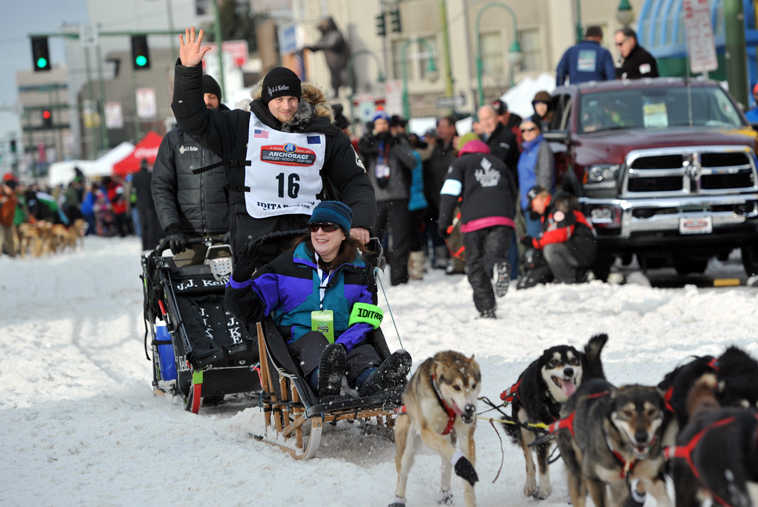ANCHORAGE — Wagging tails and smiling faces were plentiful in downtown Anchorage on Saturday as fans got to interact with the real stars of the Iditarod — the sled dogs.
Thousands of people lined the route for the ceremonial start of the Iditarod Trail Sled Dog Race. It’s an event designed for fans, allowing them to interact with the mushers, take photos and pet the dogs.
The “ceremonial start is honestly the most fun day because you really get to show everyone, I mean, all of Anchorage and then plus everyone whose come here, your sport. And you get to show it with passion, which is so cool,” said Aliy Zirkle, a fan favorite who has four top five finishes in the last four Iditarods.
“So running down Forth Avenue, 12 dogs, someone in your sled, it’s fun and it should be fun,” she said.
The ceremonial start in Anchorage went forward despite a lack of snow in Alaska’s largest city this winter. Snow even had to be shipped this week to Anchorage from Fairbanks for the event. After all that, it snowed about an inch Friday.
Janet Zoellick of Anchorage was so excited for the ceremonial start, she dragged her boyfriend out of bed at 6:30 a.m. so they could get moving early.
“I said, ‘C’mon we got to get down there early. I want to get parking, I want to be in on the action, I want to meet all the mushers, I got to take pictures, I got to wish them luck,” said Zoellick.
She is a Chicago native who visited Anchorage for the ceremonial start in 2012.
“I fell in love with it, and I knew this was the land for me,” she said. Two years later, she moved to Anchorage “for good.”
The ceremonial start usually covers an 11-mile (17.7-kilometer) route, going along city streets and trails from downtown Anchorage to the east side of the city.
But the lack of snow forced organizers to shorten the race to a 3-mile (4.83-kilometer) route.
The competitive race, which spans nearly 1,000 miles (1,600 kilometers), starts Sunday in Willow, about 50 miles (80.46 kilometers) north of Anchorage. Organizers say trail conditions largely improve after Willow, but mushers are wary of the conditions.
Zirkle said Sunday is when the mood changes from the party atmosphere of the ceremonial start, where beer tents popped up on downtown streets and reindeer dog vendors were selling to the crowds.
“It’s a little more serious, kind of pull up your britches and get ready to race,” Zirkle said.
Brent Sass, who finished second in this year’s 1,000-mile Yukon Quest International Sled Dog Race between Alaska and Canada, said it’s an incredibly talented field of mushers in the Iditarod and any one of them could be the favorite to win.
“I’m not even going to begin to mention them because there’s at least 20 teams that could win this race this year,” he said, including one of the eight mushers in the race from Norway.
Zirkle laughed when asked the same question, but had a more direct answer. “Who’d I put money on? Me!” she said, laughing again and pointing at herself with both hands. “Might as well say it.”
There are 85 mushers signed up for the race, which crosses long stretches of unforgiving terrain, including two mountain ranges and the wind-lashed Bering Sea coast.
There are seven former champions in the field, including Dallas Seavey. He has won three out of the last four races, and his only loss in that span was to his father, Mitch Seavey, in 2013.
Among the other former winners is two-time champ Robert Sorlie, 58, a firefighter in Oslo, Norway. In 2003, he became only the second man born outside the United States to win the race, a feat he repeated in 2005. He says this is likely his last Iditarod, citing age and costs associated with the race.
Sass has corrected a major mistake from last year’s race. He was disqualified by Iditarod officials because he carried an iPod Touch with him on the trail to listen to music. But race officials said he could have communicated with the outside world because it could connect with Wi-Fi.
“No iPod this year,” he said laughing. “For obvious reasons.”

